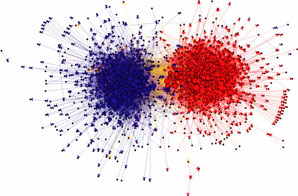
Social media world is abuzz about the upcoming US election. Who has the upper hand in the debates? Who has the better budget plan? Who has the heart of the middle class voters? How are social media users trying to influence their favorite candidates? In an effort to understand some of these questions, it is probably useful to draw some background knowledge from social theories and psychological research to understand these phenomenons.
First, there is the research on impression formation. Psychologists have long known that impression formation is deeply connected to priming effects, but yet are the subject of considerable debate. Priming is the exposure of some stimulus influencing the response to a later stimulus, including perceptual, semantic, or conceptual stimulus repetition. For example, repeatedly seeing the word "economy" associated with a candidate help influence voters to think that particular candidate cares more about the economy. Despite the recent debate about whether priming effects can be replicated reliably, most psychologists agree that the effect is real in many contexts. A good overview article on priming and impression formation is done by Decoster and Claypool in 2004 [1]. So yes, some people are posting over and over again on exactly the same debate points on many social media sites, but what they’re hoping for is a priming effect when voters go to the polls.
Why is social media so important in recent elections? Well, that’s where many people are spending their spare time now, and you want to go where the attention lies. A recent report by Lee Rainie et al. at Pew Internet Research show 60% of American adults using social networking sites, and 66% of those users have engaged in political activities in social media.
Second, once the impression forms, clearly there is a lot of Assimilation Bias going on in social media. Also called confirmation bias, this is the tendency of people to favor information that confirms to their beliefs or hypotheses. We all would like to believe that voters are rational actors that evaluate the evidence presented by the candidates equally, and then make an informed decision, but in fact, of course that’s not the case. What’s worse is that Assimilation Bias contributes directly to Attitude Polarization, with people holding on to their belief stronger by actually searching for and interpreting evidence selectively.
So how does this play out in social media? Adamic and Glance’s well-known paper [2] shows this effect quite directly with a visualization, with bloggers talking mostly within their own political spectrum, and few that bridges across the spheres. Worse, some recent research posted on SSRN also suggest the spread of polarization to neighboring issues [3].
Third, once attitude polarization sets in, it appears that Social Proof adds fuel to the fire. Social Proof is the social psychology fancy word for herd behavior — the tendency to assume the action of others reflect the correct thing to do. (Sometimes network analysts will refer to this as Preferential Attachment if they’re talking about tie formation [4].) Therefore, a voter living in a blue neighborhood is more likely to vote blue, and vice versa. It’s conformity, pure and simple.
How does this play out in social media? There has been considerable debate about whether it is influence or homophily that causes people to take on certain viewpoints. A favorite topic of research particularly amongst marketers, a definitive answer will help them better understand how to spend their ad dollars (including political ads, of course!) A good place to start on reading up on this debate is with the recent publication by Aral and Walker [5] in Science.
Computational social science have a long ways to go in collaborating with social scientists, political scientists, and other information scientists in understanding these phenomenons. The wealth of data hints at the possibility of new findings and confirmation of these effects that have already been studied extensively in the lab. Beyond confirming these effects, what else might we find? How does social media affect these processes? Presumbly it helps speed them up, but perhaps there is also a negative consequence of increasing polarization? I can’t wait to find out!
References
- DeCoster, J., & Claypool, H. M. (2004). A meta-analysis of priming effects on impression formation supporting a general model of informational biases. Personality and Social Psychology Review, 8, 2-27. doi: 10.1207/S15327957PSPR0801_1
- Lada A. Adamic and Natalie Glance. 2005. The political blogosphere and the 2004 U.S. election: divided they blog. In Proceedings of the 3rd international workshop on Link discovery (LinkKDD ’05). ACM, New York, NY, USA, 36-43. DOI=10.1145/1134271.1134277 http://doi.acm.org/10.1145/1134271.1134277
-
Palmer, Carl L., Driven to Extremes? Motivated Bias and Attitude Polarization in One-Sided Communication Flows (July 10, 2012). Available at SSRN: http://ssrn.com/abstract=1733983 or http://dx.doi.org/10.2139/ssrn.1733983
-
Golder, S.A.; Yardi, S.; , "Structural Predictors of Tie Formation in Twitter: Transitivity and Mutuality," Social Computing (SocialCom), 2010 IEEE Second International Conference on , vol., no., pp.88-95, 20-22 Aug. 2010. doi: 10.1109/SocialCom.2010.22
-
Identifying Influential and Susceptible Members of Social NetworksSinan Aral and Dylan WalkerScience 20 July 2012: 337 (6092), 337-341.Published online 21 June 2012 [DOI:10.1126/science.1215842]



Join the Discussion (0)
Become a Member or Sign In to Post a Comment